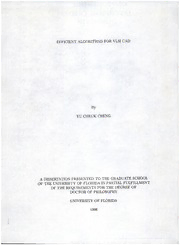
Efficient algorithms for VLSI CAD PDF
Preview Efficient algorithms for VLSI CAD
EFFICIENTALGORITHMSFORVLSICAD By YUCHEUKCHENG ADISSERTATIONPRESENTEDTOTHEGRADUATESCHOOL OFTHEUNIVERSITYOFFLORIDAINPARTIALFULFILLMENT OFTHEREQUIREMENTSFORTHEDEGREEOF DOCTOROFPHILOSOPHY UNIVERSITYOFFLORIDA 1998 ACKNOWLEDGMENTS Iwouldliketoexpress myappreciationandgratitudetomyadvisorProfessor Sartaj Sahniforhissupportandguidancetomy research work. I thankhimfor spendingalotofhisvaluabletimewithmetogivemeresearchideas. Withouthis patienceandencouragement,thisresearchwouldnothavebeendone. Iwouldalsoliketothankothermembersinmysupervisorycommittee.Dr.Tim Davis,Dr. RichardNewman,Dr. SanguthevarRajasekaranandDr. AndrewVince, fortheirinterestandcomments. IwouldliketoexpressmyappreciationtoDr. Steve Thebautforhissupportandencouragementthroughoutmystudy. Many thanksgotomyfriendshereintheuniversityaswellasthoseinHong Kongandaroundtheworld. SpecialthanksgotomyfriendDesmondKwan,who gavemeconstantsupportandencouragementthroughmyfinalyear'sPhDstudy. IwouldliketoexpressmyendlessthankstomyparentsandmybrotherEddiefor theirlove,supportandenergythroughoutmylifelongeducationalendeavors. Special thanks go to my fiancee Isabella Fungfor her love, encouragement and patience throughalltheseyearsofstudy. TothemIdedicatethiswork. u TABLEOFCONTENTS ACKNOWLEDGMENTS » LISTOFTABLES v LISTOFFIGURES vi ABSTRACT •*» 1 INTRODUCTION 1 1.1 Background 1.2 PhysicalDesignAutomation 2 1.3 DissertationOutline 3 2 TRANSISTORFOLDING 5 2.1 Introduction 5 2.2 ProblemFormulation 6 2.3 OurAlgorithm 9 2.3.1 PhaseI U9 2.3.2 PhaseII 2.4 ExperimentalResults 13 2.5 Conclusion 15 3 PERFORMANCEDRIVENMODULEIMPLEMENTATIONSELECTION 18 3.1 Introduction 18 3.2 O(plogn)AlgorithmofHeretal 22 3.3 OurO(plogn)Algorithm 24 3.3.1 Stage1 24 3.3.2 Stage2 30 3.3.3 ImplementationDetails 31 3.3.4 TimeComplexity 32 3.4 Multichannel2-PDMISProblem 36 3.5 ExperimentalResults 38 3.6 Conclusion 40 m 4 GATERESIZINGTOREDUCEPOWERCONSUMPTION 41 4.1 Introduction 41 4.2 Series-ParallelCircuits 45 4.2.1 Definition 45 4.2.2 CompleteLibraryGateResizing(CGR) 47 4.2.3 CompleteLibrarywithUpperBounds(CUGR)andConvexc(v)s 49 4.2.4 TimeComplexityofConvexGRProblem 54 4.3 TreeCircuits 62 4.4 CGRwithMultigateModulesIsNP-Hard 63 4.5 GeneralCircuits 68 4.5.1 TheCGRAlgorithmofChenandSarrafzadeh 68 4.5.2 CommentsontheAlgorithmofChenandSarrafzadeh 71 4.5.3 AUnifiedFrameworkforCGR,CUGRandConvexCGR ... 72 4.6 TheGeneralGateResizingProblem(GGR) 77 4.7 ExperimentalResults 78 4.8 Conclusion 81 5 CONCLUSIONSANDFUTUREWORK 85 REFERENCES 87 BIOGRAPHICALSKETCH 90 IV LISTOFTABLES 2.1 Runtimeandspeedupusingauniformdistribution 16 2.2 Runtimeandspeedupusingauniformdistributionwithlargerlimits 16 2.3 Runtimeandspeedupusinganormaldistribution 17 3.1 Runningtimeforbenchmarkchannels 39 3.2 Runningtimeforgeneratedchannels 39 4.1 Runtimeandspeedupwhen required timeisequal tocriticalpath length 80 4.2 Runtimeandspeedupwhenrequiredtimeisdoubled 80 4.3 Runtimeforsquar5withdifferentrequiredtime 80 4.4 PowerreductionofGGRalgorithms(1) 81 4.5 PowerreductionofGGRalgorithms(2) 82 4.6 PowerreductionofGGRalgorithms(3) 82 4.7 PowerreductionofGGRalgorithms(4) 83 4.8 PowerreductionofGGRalgorithms(5) 83 4.9 PowerreductionofGGRalgorithms(6) 84 LISTOFFIGURES 2.1 Anexamplecircuitwith4pairsoftransistors 7 2.2 TheCircuitofFigure2.1afterfoldingwithhp=4andhn=3 . . . . 7 2.3 ComputingSpandSN 10 2.4 Computeoptimalhpandhn 12 2.5 RefinedPhase2algorithm 14 3.1 Anexample PDMIS problem, (a) first implementation; (b) second implementation; (c) selectionsthat satisfythenetspanconstraints; (d)selectionwithbetterdensity 21 3.2 Criticalmodulesofneti 26 3.3 FunctionAssign 2' 3.4 Partitionaroutingchannelintoregions 29 3.5 FunctionSatisfy 33 3.6 FunctionSearch 34 3.7 Procedure Undo 34 3.8 Thetworegionstobesearchedrecursivelyafterthebinarysearch . . 38 4.1 Digraphcorrespondstoacircuit 45 4.2 CircuitExamples(Source: Lietal. [20]). (a)Chain;(b)SimplePar- allelCircuit;(c)Series-ParallelCircuit;(d)Non-Series-ParallelCircuit 46 4.3 TransformationofSeries-ParallelCircuits, (a)Chain;(b)SimplePar- allelCircuit 49 4.4 TransformationofaSeries-ParallelCircuitintoasinglegate 50 4.5 Computationofnewdelayforeachgate 51 VI 4.6 Convexdelay-power-consumptiongraph a2 4.7 AlgorithmParallel-Merge. ., 55 4.8 Worst-casemergingofngates 56 4.9 BBSTusedtorepresentDPlist{(3,28),(5,24),(3,21)} 57 4.10 Updateof£>()sandC()sforinternalnodesduringtreerotations... 59 4.11 ChangeofcvaluesofinternalnodesofL2forthefcthtupleofLi . . 60 4.12 CircuitC2thatexerttheworstcasebehavior 62 4.13 Transformationofabasictreetoasimpleparallelcircuit 63 4.14 Amodulevwithtwogates.4andB 63 4.15 VariablesubassemblyforvariableXi 64 4.16 Clausesubassemblyfor{hVl2VZ3) 66 4.17 ApplicationofalgorithmofChenandSarrafzadeh[3]onaCGRcircuit. (a)AnexampleCGRcircuit;(b)sensitivegraph 69 4.18 AsimpleexampleCGRcircuit 71 4.19 ApplicationofalgorithmofChenandSarrafzadeh[3]onCUGRcir- cuit, (a)AnexampleCUGRcircuit;(b)delayofeachgateafterfirst iteration; (c) delayofeach gateafter algorithm [3] terminates; (d) delayofeachgateforoptimalpowerreduction 73 4.20 APERTnetworkfortheCGRcircuitofFigure4.17(a) 75 4.21 TransformationofvertexvintoachaininPERTnetwork 77 vn AbstractofDissertation PresentedtotheGraduateSchooloftheUniversityofFlorida inPartialFulfillmentoftheRequirementsforthe DegreeofDoctorofPhilosophy EFFICIENTALGORITHMSFORVLSICAD By YuCheukCheng December1998 Chairman: Dr. SartajSahni MajorDepartment: ComputerandInformationScienceandEngineering Inthisdissertation,wedevelopefficientalgorithmsforthreeproblemsthatarisein verylargescaleintegratedcomputer-aideddesign(\"LSICAD):(1)transistorfolding, (2)moduleimplementationselection,and(3)gateresizing. Transistorfoldingreducestheareaofrow-baseddesignsthatemploytransistorsof differentsize. KimandKanghavedevelopedan0(m2logm)algorithmtooptimally fold m transistor pairs. In this dissertation we develop an 0(m2) algorithm for optimaltransistorfolding. Ourexperimentsindicatethatouralgorithmruns3to50 timesasfastformvaluesintherange[100, 100000]. WedevelopanO(plogn) timealgorithmtoobtainoptimalsolutionstothep pin n net singlechannel performance-driven implementationselection problem in viii whicheachmodulehasatmosttwopossibleimplementations(2-PDMIS).Although Her,WangandWonghavealsodevelopedanO(plogn)algorithmforthisproblem, experimentsindicatethatouralgorithmistwiceasfastonsmallcircuitsandupto eleventimesasfastonlargercircuits. Wealsodevelopan0{pnc~x)timealgorithm forthec,c>1,channelversionofthe2-PDMISproblem. Westudytheproblemofresizinggatestoreduceoverallpowerconsumptionwhile satisfyingacircuit'stimingconstraints. Polynomialtimealgorithmsforseries-parallel andtreecircuitsareobtained. Gateresizingwithmultigatemodulesisshowntobe XP-hard. AlgorithmsthatimproveuponthosedevelopedbyChenandSarrafzadeh forgeneralcircuitsarealsodeveloped. IX CHAPTER1 INTRODUCTION 1.1 Background ThedesignandfabricationofVLSIchipshasbeenmadepossiblebytheautoma- tionofseveralstepsinthedesignprocess. TheVLSIdesignprocesstransformsa formalspecificationintoafullypackagedchip. Itconsistsofthefollowingsteps[30]: 1. System specification: In this step ahigh level representation ofthesystem iscreated. Performance, functionality, physicaldimensions, choiceofdesign techniquesandfabricationtechnologyareconsideredinthisstep. 2. Functionaldesign:Theoutputofthisstepisatimingdiagramwhichisobtained byconsideringthebehavioralaspectsofthesystem. 3. Logicdesign: Thelogicdesign, ingeneral,isrepresented byBooleanexpres- sions. The logicdesign that representsthe functionaldesign isobtained in thisstep. TheBooleanexpressionsareminimizedtoobtainthesmallestlogic design. Correctnessofthelogicdesignisalsoassertedinthisstep. 4. Circuitdesign: Acircuitwhichrepresentsthelogicdesignofthesystemisde- velopedinthisstepbytakingintoconsiderationspeedandpowerrequirements, andtheelectricalbehaviorofthecomponentsusedinthedevelopmentofthe circuit.
